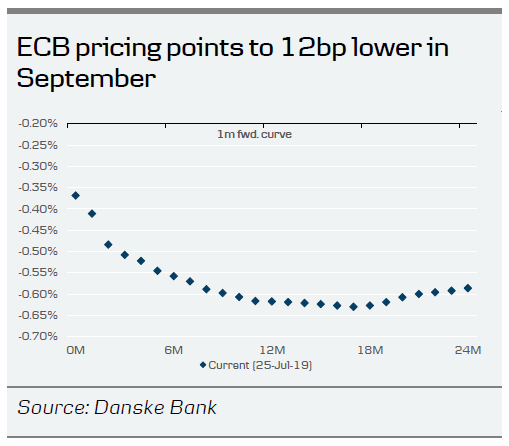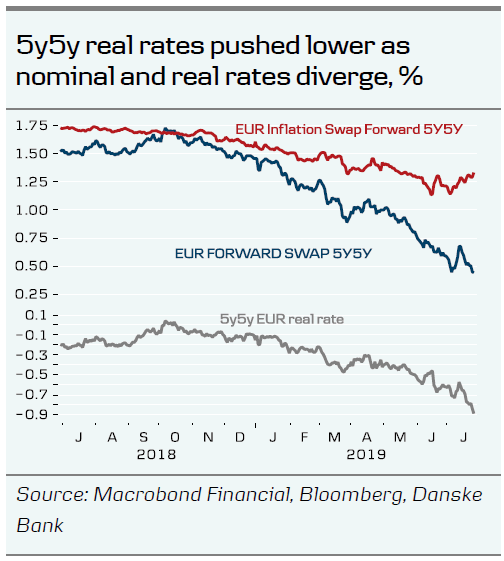- It is a matter of how the ECB will act, no longer if. The ECB tasked committees to examine the potential QE restart, rate cut, tiering and forward guidance, although there were no details on rate cut size, QE size, limits etc.
- The economic assessment in the statement was virtually unchanged although Draghi said that the economic outlook is ‘getting worse and worse’ as well as ‘inflation expectations declining’.
- Draghi went to great lengths today to emphasise symmetry in the inflation mandate where both realised and projected were mentioned.
- Markets will keep speculating about the composition of the stimuli, but were somewhat disappointed with the lack of details
At the July meeting Mario Draghi sent a strong signal to the market, that further stimulus is on its way to help the ailing economy. As we expected, the ECB adjusted the forward guidance as a first step, opening up the possibility of policy rates remaining ‘at present or lower levels’ at least through H1 20. In our view this has set the scene for a deposit rate cut, which we expect to be announced at the September meeting (we expect a 20bp rate cut), paired with a restart of the QE programme and extended forward guidance (see ECB Research: New ECB call – rate cut and restart of QE, 18 June 2019). Markets are currently pricing 12bp of cut in September.
However, while Draghi more or less pledged that a highly accommodative monetary is going to be needed for a prolonged period of time, he remained deliberately vague on the what/when/how of the exact policy measures, which tasked committees have been charged with examining until September. Tasked committees have previously been used with bigger changes in monetary policy measures.
One novelty in the ECB’s statement related to the emphasis on the symmetry of the inflation aim (both realised and projected where mentioned). Draghi indicated that inflation could overshoot the target at the Sintra speech six weeks ago.
The ECB’s assessment of the inflation and economic outlook and risks was broadly unchanged. While resilience is still apparent in the service and construction sectors, Draghi also stressed the outlook was getting worse and worse, especially in manufacturing. This means the expected rebound in H2 19 is now less likely with incoming data. The risk of recession was seen as ‘pretty low’ (from ‘very low’ in June).
The language on the inflation outlook was slightly more subdued, as the pass-through from labour cost pressures to inflation is taking longer than expected. In that light, Draghi stressed that the GC is not happy with the achievements on the inflation front and will not accept permanent undershooting of its target.
All this reinforced the message of a more uncertain inflation and growth outlook, that will be the base of the easing package to be unveiled in September.
FX: our fundamental predisposition is to buy EUR/USD
The initial reaction in FX markets was to send EUR/USD to a new multiyear low just above 1.1100. During the press conference, however, EUR/USD rebounded as little confirmation news was delivered to the EUR bears hence triggering profit taking. At the time of writing EUR/USD is trading higher than before the ECB meeting albeit still little changed relative to the opening levels this morning of close to 1.1150.
From an FX perspective we think the crucial part of the signalled easing package lies in rate cuts (see FX Edge: The EUR and ECB – rate cuts are all that matter, 12 July 2019). A sizeable cut in the deposit rate (and 20bp is a bare minimum in our view) would force a greater share of excess liquidity on the market, help turn around inflation expectations and weaken the EUR. However, history has shown that market expectations have tended to exceed the ECB’s eventual easing package announcement at the time of the ECB policy meetings. In addition, if a September rate cut is delivered together with a tiering system it would in our view diminish the negative EUR FX impact. Also FOMC rate cuts and a cyclical stabilisation in H2, all else being equal, would constitute EUR/USD supportive factors. As the speculative leverage funds segment remains heavily short EUR/USD according to the weekly CFTC IMM data (IMM Positioning Update, 21 July) a change of the H1 environment could add to the move higher in the cross this autumn. Consequently, our fundamental predisposition is to buy EUR/USD dips on a strategic bias on this ECB message.
Fixed income: more support to European fixed income
European fixed income markets initially rallied on the back of the easing ‘package’ from Draghi. The hunt for yield or the struggle to avoid negative yields will as a consequence intensify and real yields were pushed a new leg lower. That said, later in the day nominal yields moved higher as the market got no new details during the press conference and as inflation expectations moved higher. In respect of the latter, notice that 5y5y EUR inflation swap moved 4bp higher to 1.33% and that 5y5y EUR real rates fell 5bp to -0.89% over the day.
We have so far called for a test of -0.45% for 10Y bund yields and we stick to this view ahead of the September meeting with more downside potential. Rate cuts would according to the textbook lead to a curve steepening 2s10s, 5s10s, 10s30s etc. as long-term inflation expectations are pushed higher. However, given the upcoming QE programme and the struggle to avoid negative yields we argue it is too early to move against the flattening trend in European bond markets.
Given the Draghi package we keep our positive view on semi-core and periphery. Our favourite in the periphery has for a long time been Spain and Portugal, and Finland in semicore. The strong demand for duration and positive yields means that Italy can be expected to continue to tighten versus core markets.
















